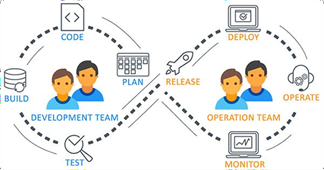https://www.youtube.com/watch?v=0voV4-MUOGg
Click to below link – DevOps Lessons from Formula 1
https://www.devopsgroup.com/blog/devops-lessons-formula-1-part-2/
DevOps Practices
- Agile planning. Together, we’ll create a backlog of work that everyone on the team and in management can see. We’ll prioritize the items so we know what we need to work on first. The backlog can include user stories, bugs, and any other information that helps us.
- Continuous integration (CI). We’ll automate how we build and test our code. We’ll run that every time a team member commits changes to version control.
- Continuous delivery (CD). CD is how we test, configure, and deploy from a build to a QA or production environment.
- Monitoring. We’ll use telemetry to get information about an application’s performance and usage patterns. We can use that information to improve as we iterate.
How DevOps Works?

Under a DevOps model, development and operations teams are no longer “siloed.” Sometimes, these two teams are merged into a single team where the engineers work across the entire application lifecycle. Starting from design and development to testing automation and from continuous integration to continuous delivery, the team works together to achieve the desired goal. People having both development and operations skill sets work together and use various tools for CI-CD and Monitoring to respond quickly to customers need and fix issues and bugs.
Benefits of DevOps over Traditional IT
Speed + Rapid Delivery + Reliability + Scale + Improved Collaboration + Security
With DevOps, teams:
1.Deploy more
frequently
In fact, some teams deploy up to dozens of times per day. Practices such as
monitoring, continuous testing, database change management, and integrating security
earlier in the software development process help elite performers deploy more
frequently, and with greater predictability and security.
2.Reduce lead time from commit to deploy
Lead time is the time it takes for a feature to make it to the customer. By
working in smaller batches, automating manual processes, and deploying more
frequently, elite performers can achieve in hours or days what once took weeks
or even months.
3.Reduce change failure rate
A new feature that fails in production or that causes other features to break
can create a lost opportunity between you and your users. As high-performing
teams mature, they reduce their change failure rate over time.
4.Recover from incidents more quickly
When incidents do occur, elite performers are able to recover more quickly.
Acting on metrics helps elite performers recover more quickly while also
deploying more frequently.
How you implement cloud infrastructure also matters. The cloud improves software delivery performance, and teams that adopt essential cloud characteristics are more likely to become elite performers.
The information here is based on DevOps research reports and surveys conducted with technical professionals worldwide.
Organizations that have implemented DevOps saw these benefits:
1.Improved Quality of Software Deployments -65%
2.More frequent Software Releases –63%
3.Improved visibility into IT process and requirements –61%
4.Cultural change (Collaboration and Cooperation) –55%
5.More responsiveness to Business Needs –55%
6.More Agile Development –51%
7.More Agile Change management process –45%
8.Improved Quality of Code –38%

